To begin keying, compare the specimen at hand to the illustrated and described shape categories below. After
determining the best fit, go to the dichotomous key for that category to continue the identification process. Bear
in mind that only one picture is used here to illustrate an entire group. Pay as much attention to the description as to the
single image. Once you are more familiar with the shape categories, you can go directly to the keys via the menu below.
Example |
Shape Category |
Description |
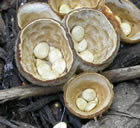 |
Bird's Nest
Key
Species List
|
These fungi look like miniature bird's nests with egg-shaped
structures inside called peridioles. Bird's nest fungi are small, only
0.5 to 1 cm in diameter. Drops of water splash the peridioles out
of the cups, dispersing the fungus. |
 |
Club, Coral and Leafy
Key
Species List
|
Fungi with an upright club-like (unbranched) or coral-like (branched)
growth habit comprise this grouping. Some occur as single, upright,
club-like
structures.
Others, as
illustrated here, are clustered and
highly
branched. Some
forms have
flattened branches giving them a
leafy
appearance.
None of them
form pores or gills. |
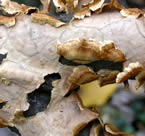 |
Crust and Parchment
Key
Species List |
Species in this grouping are either 1) sheetlike, crustlike, and spreading over the substrate or 2) projecting away from the substrate as tough, leathery, parchment-like caps or 3) some combination of crustlike and projecting portions. The fertile
surface may be smooth,
rough, or bumpy but never forms pores, gills, or
teeth. Fuligo septica may be found as a gooey spreading mass at first before becoming dry and powdery. |
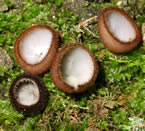 |
Cup and Saucer
Key
Species List |
Ranging from less than a mm to several cms in diameter, these fungi
have the appearance of a flattened saucer or disc or of a cup. The
underside may be stalked or not.
The smooth, upper fertile surface
may or may not be differently
colored from the lower surface. |
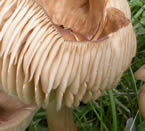 |
Gilled
Key
Species List |
Fungi with a lower surface bearing radiating plates or gills are
grouped here. These fungi are fleshy and the gills are readily
separable from the rest of the mushroom. Certain poroid fungi (e.g.,
Lenzites betulina, Gloeophyllum sepiarium) have
pores which "break
down"
and form gill-like structures. Unlike the true gilled fungi,
the "gills"
of these poroid fungi
have a tough texture and are not readily
separable
from the
rest of
the fungus. |
 |
Jelly
Key
Species List |
Organisms in this group share two characteristics.
First, a fresh specimen must be jelly-like in texture (i.e., soft and gelatinous).
Second, the fruitbodies are irregular in shape. These fungi do not form teeth,
spines, pores, or gills. Many of these fungi first appear as individual
fruit bodies which are irregularly lobed or convoluted or described
as brainlike in appearance. In time, these may fuse with others to
form
large irregular masses 10-20 cm or more long. |
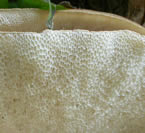 |
Poroid
Key
Species List |
Poroid fungi have many holes (i.e., pores) or pits that comprise the
fertile surface. These holes are the
openings of tubes these fungi
form. Spores form on the interior walls of the tubes. Pores may be
large (e.g., each
over 1 mm diameter) or very small (5-7 pores per
linear mm). Use a
10x hand lens before deciding your specimen does
not form pores. |
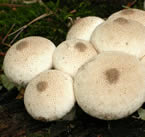 |
Puffball and
Cushion
Key
Species List |
If the fungus has the general shape of a ball, then it is placed in this
category. The ball-like structure may be somewhat compressed (cushion-shaped) or pear-
shaped or turban-shaped. It may be stalked or
sessile, hard or
soft, smooth or
lumpy. These organisms do not have
the "open" or "flat top" look of the cup and
saucer fungi. They do not
have the peridioles of the bird's nest fungi. They are
not as narrow in relation to their height as are the club and coral fungi nor do
they form branches. |
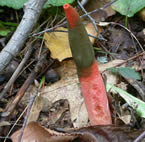 |
Stinkhorn
Key
Species List |
Stinkhorn fungi would fall into the club, coral, and leafy shape
category but
for one feature: at maturity, the terminal portion of the
stalk-like
stinkhorn is covered by a brownish-green, foul-smelling
gooey slime.
The slime is loaded with spores and attracts flies which
disperse the
spores. |
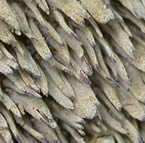 |
Teeth and Spine
Key
Species List |
Fungi in this group form
either flattened teeth-like structures or rounded spine-like
structures which are either 1) oriented downward (pendulous) in contrast to the upright
stalks
of the club, coral, and leafy group or 2) occur as a spreading mass of spines or teeth on the substrate. In the latter case, the teeth/spines are tough in texture and just a few millimeters long. Certain poroid fungi (e.g. Irpex lacteus, Cerrena unicolor) have tubes which break down to form "teeth." |









